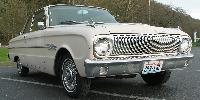I bought a 1963 sales brochure called "Falcon for '63! Now with V-8's."
The specifications for the Ford-O-Matic Drive says that they use a torque converter with a torque multiplication of 2.4 on the Sixes and 2.05 on the V-8.
My question is: Why did they use a lower torque multiplication on the V-8? I know that the V-8 has a higher torque to begin with than did the Six so it could make do with less multiplication. But what would have been the down side of the higher multiplication? What was the advantage that was gained by reducing the multiplication on the V-8?
My thought is that maybe it lowered the operation temperature of the transmission in stop and go traffic. Does that sound correct?
One other question: Would it be possible to hook a six cylinder Ford-O-Matic torque converter to a V-8 to get a quicker take-off?
Specifications:
Fordomatic Transmission gear ratios: 4.20*, 1.75, 1 (1960-1962)
Fordomatic Transmission gear ratios: 4.37*, 1.82, 1 (1963 Sixes)
Fordomatic Transmission gear ratios: 3.73*, 1.82, 1 (1963 V-8)
3-speed manual transmission: 3.29, 1.75, 1
4-speed manual for 170 Six: 3.16, 2.21, 1.41, 1
Sprint 4-speed manual for 260 V-8: 2.73, 2.04, 1.51, 1
*1st and torque converter. The 1963 Fordomatic has a torque converter multiplication of 2.40 (sixes) and 2.05 (V-8) when the turbine is stalled providing a maximum overall reduction of 4.37 or 3.73 when the throttle is hit hard. Stall is an operating condition where the turbine is stationary and the engine throttle is wide open, making the rotational speed of the impeller as high as possible. Stall can be approximated to when a vehicle moves from rest. Maximum torque multiplication occurs instantaneously as the vehicle begins to move.
Me with transmission.jpg




 Reply With Quote
Reply With Quote


Bookmarks